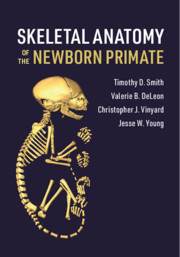Book contents
- Skeletal Anatomy of the Newborn Primate
- Skeletal Anatomy of the Newborn Primate
- Copyright page
- Contents
- Foreword
- Preface
- 1 Introduction
- 2 Primate Development and Growth
- 3 Why Ontogeny Matters
- 4 The Skull
- 5 Dentition
- 6 The Postcranial Axial Skeleton
- 7 The Pectoral Girdle and Forelimb Skeleton
- 8 The Pelvic Girdle and Hindlimb Skeleton
- 9 The Newborn Primate Body Form: Phylogenetic and Life-History Influences
- 10 Ontogeny of Feeding
- 11 Ontogeny of Locomotion
- References
- Index
- Atlas
3 - Why Ontogeny Matters
Published online by Cambridge University Press: 23 March 2020
- Skeletal Anatomy of the Newborn Primate
- Skeletal Anatomy of the Newborn Primate
- Copyright page
- Contents
- Foreword
- Preface
- 1 Introduction
- 2 Primate Development and Growth
- 3 Why Ontogeny Matters
- 4 The Skull
- 5 Dentition
- 6 The Postcranial Axial Skeleton
- 7 The Pectoral Girdle and Forelimb Skeleton
- 8 The Pelvic Girdle and Hindlimb Skeleton
- 9 The Newborn Primate Body Form: Phylogenetic and Life-History Influences
- 10 Ontogeny of Feeding
- 11 Ontogeny of Locomotion
- References
- Index
- Atlas
Summary
Vertebrates may be born highly dependent (altricial) or may rapidly gain independence (precocial). Primates are generally considered somatically precocial. However, all are at least initially helpless, and many primates have a prolonged phase of juvenility. In this chapter, we discuss how selection may influence the relative timing of appearance of morphological features (heterochrony). Newborn primate morphology offers unique insights into the roles of prenatal and postnatal growth processes, primarily because metabolic costs for growth commence a transition from the mother to the infant at this point in time. With this in mind, primates vary remarkably at birth in dental eruption and mineralization status as well as limb skeleton ossification (e.g., wrists and ankles). We also discuss evidence, still relatively scant, that at birth primates vary greatly in the degree to which neural organs (e.g., brains, eyes) have achieved adult size and proportions. In preparation for morphological descriptions to follow, the reader is introduced to the concept of modularity of growth: different parts of the skeleton or even parts of regions have different rates of growth and development.
- Type
- Chapter
- Information
- Skeletal Anatomy of the Newborn Primate , pp. 28 - 36Publisher: Cambridge University PressPrint publication year: 2020

